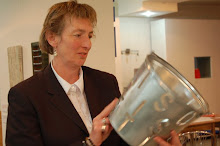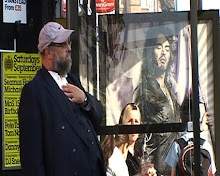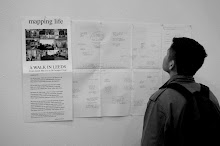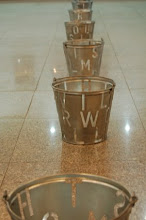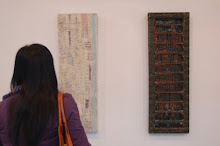Орчуулгыг Цэгмидийн Цэндпүрэв
(eng. translation by Tsendpurev Tsegmid)
Хөндлөн Урсгалууд
Миний бодлоор энэ үзэсгэлэнг хамтад нь барьж байгаа хэлхэсүүд нь цаасан шувуудын уяанууд шиг, олон янзын өнгөтэй шувууд, араатан амьтад эсвэл хийсвэр дүрсүүд болж эсрэг урсгалт салхины аясаар нэг бол хоорондоо давхцан нэг бол урд хойноо оролцон ниснэ.
Төслийн санаа нь Монгол Улсын Улаанбаатар хотоос Их Британий Лийдс хотод Орчин Үеийн Дүрслэх Урлагийн чиглэлээр сурахаар ирсэн оюутан Цэгмидийн Цэндпүрэвийн нийгэм, улс төр, соёл урлагийн онцлог нөхцөл байдлаас үүдэн гарсан билээ. Түүний хувийн аялал нь газарзүйн, дээд боловсролын байгууллага болон соёл урлагийн орон зайд Рози Брайдоттын үгээр бол “нэвтрэхүй ба биежихүй”-ийн үйл явц шиг шилжин суурьшихуй, өөрчлөлтийн тухай урлагт хэрхэн тусган харуулах талаар өөрөөр эргэцүүлэх арга замыг хөгжүүлэхэд дөхөм болсон юм.
Энэ үзэсгэлэн нь түүний хувийн аялалынх нь үр дүн болж урлагийн үүргийг зуучлал, өөрчлөлт ба хүчтэй нөлөөллийн үйл явц гэж үзсэн эргэцүүлэл болон ирсэн ба, энэ нь глобалчлал ба нүүдлийн соёл иргэншлийн талаарх пост-модернист үзлийн эсрэг урсгал болно. ‘Одоо’ гэдэг монгол үг болон урсгал гэдэг үгнүүд нь хоюулаа түвэгтэй олон утгатай ба цахилгаан гүйдэл, салхи болон усны урсгал гэх мэт. Арлын улсаас тэнгисгүй орон руу хийж байгаа бидний аялал бол бие махбодын төдийгүй, соёл урлагийн болон нийгмийн солилцоо бөгөөд энэ каталогийн газрын зураг нь тухайн ухагдахууныг илэрхийлсэн давтагдсан дүрслэл зурагнууд болон орчуулагдсан текстийн тусламжтайгаар судалж байгаа билээ.
‘Одоо’ төслийн бусад аялалуудад Ёвропоос Оросын Холбооны Улсаар дамжин тэр бат бэх хүчирхэг удирдлагын дор оршдог агуу уудам газар нутгийн гадаад захаар шүргэн өнгөрөх галт тэргээр хийж байгаа аян, Мариа Линдийн үгээр бол “холбоост зах хязгаар” буюу, байнга өөрчлөгдөх хилийн шугамууд, түүнтэй адилаар улс орон хил, бие хүний тухай ойлголтууд нь хүч хэрэглэсэн түвэгтэй байдлаар оршиж байдаг тэр замыг туулах ба, мөн цаг хугацаа ба орон зайг товчилдог нисэх онгоц нь олон улсын спортын одод, ажил хэрэгч эрхмүүд, улс төрчид, урлаг судлаачид ба уран бүтээлчдийн бас нэгэн сонголт юм.
Түүхийн болон одоогийн нөхцөл байдлын шаардлагаар шинэ улс үндэстэн шинэ бие хүмүүсийг бий болгох, зурвас заагийг дахин үүсгэх, хүч хэрэглэсэн шилжин суурьшилтын явцад амь насаа алдсан тэр хүмүүсийн гаргасан замаар бид хил хөндлөн гарна. Тэр бүх алдагдсан түүх болон мартагдсан бие хүмүүсийг яаж ахин эргэн санах вэ? Харин Орчин Үеийн Урлагийн дадлагууд нь тэр дурсамжийг ахин шинээр сэргээх, дахин санах болон ахин урлан бүтээх замаар нөхөх боложтой.
Энэ үйл явц нь үзэсгэлэнд оролцож байгаа зарим уран бүтээлчдийн хувьд хүмүүсийг байрлал болон хамаарлаар ахин холбоход видео болон фото зургийн үүрэг чухал бөгөөд, фото зураг нь индекс маягаар бие махбодийн үнэн бодит байдлийг дүрслэн харуулдаг буюу эсвэл үзэгдэл нь видеонд мөрөө гаргадаг бөгөөд энэ нь цаг хугацаа орон зайнд өөрийн тэмдэгээ үлдээж буй хэрэг билээ. Мариа Линдийн хэлсэнчлэн “Индекс Арт” бол голдуу жижиг хэмжээний төслүүд байх ба өдөр тутмын амьдралд ойрхон, нийгмийн оролцоо болон хувийн туршлагаар нөлөөлөгдсөн, заавал уран бүтээлч гэсэн тогтсон нийтлэг ойлголтыг тэжээхгүйгээр бие хүний онцлог ул мөрийг үлдээх гэсэн хүсэл юм.
Нүүдлийн буюу глобалчлагдсан энэ дэлхий нь хөрөнгөтний нийгмийн сүүл үеийн эдийн засаг, соёл урлаг, улс төрийн шаардлагуудыг хангаж байна гэж олон хүмүүс шүүмжилдэг бөгөөд Хоми Бхабхагийн сануулсанчлан “ Дэлхийн бөмбөрцөг нь түүнийг эзэмшдэг хүнд бол багассаар харин шилжин суурьшсан, хамаг байдгаа хураалгасан, нүүдэлчин эсвэл цагаач нарын хувьд ямар ч холын зай нь хэдхэн алхмын цаадах хилийн шугам буюу хил хязгаарын заагнаас илүү амьсгал давхцахаар айдас төрүүлэм мөн гайхамшигтай байж чадахгүй билээ”.
Энэ үзэсгэлэнгийн төслийн хэтийн зорилго бол нэгээс нөгөө газар руу хийх хөдөлгөөн, тайлбар орчуулга, шилжин суурьшихуйтай холбоотой төрөл бүрийн ухагдахуунуудыг сонирхон авч үзэх бөгөөд, дотоод болон гадаад гэдэг ойлголт нь ёроолоос нь текст гарч ирдэг төмөр хувингуудын зохион байгуулалт шиг гүн ухааны болон практикийн шинж чанартай. Өөрөөр хэлвэл техник технологийн тусламжтайгаар сүлжээгээр холбогдсон орчин үеийн дэлхий ертөнц маань бас л салхи, цаг агаар болон тайлбар орчуулгаар эвдэгдсэн хэвээрээ байгааг илрүүлэн харуулж байгаа юм.
Нүүдлийн соёл иргэншлэл нь Монголын соёлын бат бөх хэсэг ба тэр ойлголт нь бидэн шиг колоничлолын их түүхтэй жижиг арал дээр амьдардаг барууны уран бүтээлчдийн ойлголт болон туршлагаас их өөрөөр ойлгогдож ирсэн билээ. Нүүдэлчин гэдэг ойлголт нь барууны гүн ухаан болон соёлд маш сонирхолтой сэдэвт тооцогддог бөгөөд, энэ нь олон янзын соёл, газар нутаг, байршлуудаар салангид аялал хийснээрээ гүн ухааны болон онолын орон зайд нэвтрэн боломж өгдөг билээ.
Би өөрийнхөө хийсвэр сэтгэлгээнд цаасан шувуудаа нисгэхэд Монголын салхи урлагийн үйл ажиллагаанд урин дуудаж, фэминистүүд олон улсын түвшинд маргалддаг шиг энэ бол дэлхий нийтийн ойлголт болон нэг санаат хүмүүнлэгийн ухааны үзэл санааг үл зөвшөөрөхтэй адил юм.
Уран бүтээлчийн хувиар аялах мэт эсвэл нүүдлийн үзэсгэлэнгийн аяны цүнх, хайрцаг, авдарнууд доторх урлагийн бүтээлүүд нь Цэгмидийн Цэндпүрэвийн судалгааны ажилд тусгаснаар барууныханы колоничлолын хэвшмэл соёлыг гэрчлэх тухайн шинжилгээний экспедицэд оролцогчдын нэг Жанет Вулсинийг эргэн сануулах бөгөөд, тэрээр 1920-иод оны Монголын газар нутгаар байнга хуримтлагдах ачаагаа тээсээр аялсан ба Ню-Йорк хотын эрх ямбатай чинээлэг иргэний нүдээр гэхдээ голчлон эмэгтэй хүний үүднээс ажиглан харж бичиж тэмдэглэн, фото зургуудыг авснаар одоогийн Харвардын Их Сургуулийн дэргэдэх Пийбодигийн Архелоги Угсаатны Судлалын Музейн цуглуулга дахь ангилахад түвэгтэй архивыг бий болгожээ.
Энэ тийм ч аятайхан биш. Соёлын онцгой мөчүүд, шинэ танилууд, байршил газар нутаг орон зайд ижил цаг хугацаанд явагдах үйл явдлуудтай тулгарах нь бидний ертөнц дахь өөрсдийн хүвь хүний тухай мэтгэлцээнийг гарган ирдэг ба өөрсдийн тухай дахин асуухад хүргэдэг нь дамжиггүй юм. Жишээлбэл хэн ер нь Монголоос ирсэн уран бүтээлч, Их Британий хойд хэсэгт орших Ливерпул хотод болдог “Aintree” нэртэй морины уралдаан дээрх корпорацийн “тансаг” хүлээн авалтны зөөгчөөр байгаад ажил хэрэгч эрмүүдийн толгой дээгүүр Чингис Хаан нэртэй морь холын хашлагат тэмцээнд түрүүлэхийг харна гэж бодох билээ?
Улс төрийн газарзүйн хэлээр илэрхийлэгдсэн тунхаглалууд, түүний төвлөрөл ба зах ирмэгийн тогтносон бүтэц рүү хийгдэж байгаа энэ гэнэтийн эвдрэл буюу хагаралыг хамтрах хэлбэрээр эсвэл урлагийн төрөл бүрийн дадлагуудыг оролцуулан судлаж болох юм. Кураторынхоо хувьд би Лиам Гиллик болон Мариа Линдийн үгээр бол “хөнгөхөн ачаатайгаар үзэсгэлэн буй болгох” тухай боломжтой юу? Миний ачаа нь төмөр хувин, фото зураг, зураасан зураг, перформанс арт, олон янзын ойлголт, дурсамж, үзэл санаа, итгэл болон айдсаас бүрдэнэ.
Үзэсгэлэнг бий болгох явц нь яг олон төрлийн гүн ухааны ухааны ухагдахууны хязгаараар, тогтсон дүрэм журмууд болон соёлын нөлөөллийг даван, улс үндэстний хилээр болон олон янзын бие хүмүүсийн үзэл бодлыг тээн контрабанд хийж байгаа юм шиг мэдрэмж төрүүлж байна. Өөрөөр хэлвэл эд бараа юм уу эсвэл хүмүүсийг хууль бусаар оруулах шиг, тэр нь улс гүрний хууль журамтай зэрэгцэн олон хөлийн орон зайд орших ба мөнхөд өөрчлөгддөг далайн эрэг шиг.
“Чи байх ёстой газраа нүдэнд харагдахгүй болж өөр нэгэн газар эргэн гарч ирэх” нь сонирхол татахуйц ойлголт бөгөөд энэ нь бидний амьдралын нэг хэсэг болох өөрчлөлтөнд удаан ханддаг нүсэр зохион байгуулалттай соёлын байгууллагуудын эсрэг гаргадаг мэдээжийн бодлого болдог, жишээ нь интернетийн сэтгэл татах чанар нь түүний гарч ирж болж болдог компьюторийн аргаар бий болгосон орон зайтай ямар нэгэн байдлаар холбоотой юм.
Урсула Биемэнний олж тогтоосноор хөрөнгөтний нийгмийн сүүл үеийн шинэхэн эдийн засгийн эзэнт гүрнүүдийн хилийн зурвасын одоогийн байдал нь зөвшөөрөлтэй эд барааг хил дамжуулах, цэргүүд, жуулчид, эдийн засгийн цагаачид, загасчдын хөдөлгөөн болон хахуульд автагдсан нэг хэсэг нь хууль бусаар хил давах боломж олгох, нууцаар хил давагчдын хөдөлгөөнийг удирдан хянах зэрэг зорилготой байнгын эргүүл хийх шаардлагаар тодорхойлогдоно. Үүн дээр тэрээр засгийн газрын төлөөлөгчид, эрдэмтэн багш судлаачид болон уран бүтээлчдийг нэмж болохоор. Хиймэл дагуулын ажиглалт, цэргийн цахим мэдээлэл цуглуулах систем болон хилийн зурвасын видео тоног төхөөрөмжүүд гэх мэтчлэн технологиуд нь энэ газарзүйн хүчирхэг шинэ холбоо харилцаанд чухал үүрэг гүйцэтгэдэг.
Биемэнн урлагийн төслүүдийг улс төр, хил хязгаар, газарзүйтэй холбоотой асуудалд уран бүтээлчээр хандан судладаг байршлуудтай адилтган үзсэн бөгөөд газрын дундад тэнгисийг орчин үеийн колоничлолын эдийн засгийн холбоо харилцаан дээр тулгуурлан газрын зураг мэт хатуу орон зайд жуулчид, цагаачид, дүрвэгчид, цэргүүдийг үл гэрэлтдэг гадаргуу дээр амьдарч байгаа мэтээр “Multiplicity” урлагийн групийн бүтээсэн “Хатуу Тэнгис” нэртэй төслийг жишээ болгон авч тайлбарласан байдаг. Тэнгисийг хатуулаг гадаргуу болгох гэдэг санаа нь одоогийн Монголын гүн гүнзгий ба түвэгтэй нүүдэлчний соёлын уламжлал, хуучнаар СССР-ын ноёрхол болон хөрөнгөтний нийгмийн сүүл үеийн эдийн засгийн хүчний нөлөөнд орж эхлэх хүртэлх түүхэн хилийн зурвасаас бүрдсэн далайгүй эх газрын ойлголтыг сөхөн гаргаж ирдэг. Энэ төсөл нь Рози Брайдоттийн хэлснээр олон иш татлалаас бүрдсэн, хил хязгаарыг хөндөлсөн орон зай, нэгээс нөгөө тэнхлэг рүү хийж буй үсрэлт, шугаман биш гэхдээ замбараатай, нүүдлийн боловч хүчээ дайчилсан хариуцлагатай гэж тайлбарласан “оюуны солилцоо ба шилжилт” гэдэг санааг гаргаж тавих зорилготой гэж үзэж болох юм.
Үзэсгэлэнгийн төслийн бүтээлүүдийг бий болгох нь нэг улсаас нөгөө улсын хооронд хилийн гадна болон дотор талын зурвасаар шилжих, хувийн ба олон нийтийн байнга өөрчлөгдөх орон зайтай төстэй байсан гэж хэлж болно. Мөн бид галлерейн орчинг идэвхтэй солилцоо явагдах, санал бодлоо илэрхийлэн ярилцах завсар дундын орон зай гэж үзэх хүсэлтэй байгаа билээ.
Энэ утгаараа үзэсгэлэнд оролцож байгаа хэсэг уран бүтээлчид өөрсдийн санааг бүтээл болгохын тулд олон нийтийн болон хувийн орчны хооронд шилжин хөдөлж, тухайн орон зайд түр хугацаагаар амьдарч бие махбодийн оролцоог бий болгох “performative” арга хэлбэрийг ашиглаж байгаа. Зарим перформанс бүтээлүүд нь Их Британид олон нийтийн хүртээл болсон бөгөөд Монголд мөн тоглогдох ба тэр бштээлүүд нь тухайн орон зайд энгийн ярианы хэлний тойргоос бие махбодийн дуу хоолой руу аажмаар хувирч бүтээлч, улс төр, соёл, нийгмийн орчинд түвэггүй аялах боломжийг эрэлхийлэх юм. Салхинд дуу хоолой дуурсана.
Эдгээр нэгээс нөгөөд шилжих, олон хэсэгт хуваагдах, шилжин суурьших хөндлөн урсгалуудаас бид хорвоог өөрөөр төсөөлөх, тодорхой газар нутаг, хувь хүний онцлог болон түүхийн тухай олон төрлийн замаар эргэцүүлэн ярилцах боломжийг бидэнд гаргаж өгч байна. Үзэсгэлэнгийн бүтээлүүд Монголын Дүрслэх Урлагийн уламжлалт өөрийн гэсэн онцлогтой хувь хүн, байршил болон түүхэд хандах арга замтай холбоо үүсгэх нь дотоодын болон дэлхийн түвшин дэх орчин үеийн урлагийн олон янзын урлагийн дадлагуудын тухай хэлэлцүүлэгт шинэ арга замыг нээж өгөх чухал замыг нээж өгнө гэж бид итгэж байгаа.
Энэ үзэсгэлэнгийн төсөл нь Монголтой худалдаа арилжаа наймааны солилцоо тогтоох хүсэлтэй дэлхийн эдийн засгийн үйлвэржсэн төвүүдийн нэг болох Лийдс хот, “нөхөрлөл” хамтын ажиллагааны боломжыг хайж байгаа их сургуулиудын харъяа дээд сургуулиуд болон улсын байгууллагуудын сонирхлыг мөн хөдөлгөж байгаа.
Энэ төслийн өөрийгөө бий болгон бүтээгч шинж чанарыг тодорхойлогч нь соёлын орчинд олон төрлийн хэлбэрийн харилцаа үүсгэж болох боломжийг бүтээхэд нөлөөлөх арга замыг хайж байгаа дээд сургуулийн хяналтын завсрын орон зайд хамтран ажилласан бүтээлчдийн цуглуулга биш гэвэл эрчим хүчтэй сэтгэл санаагаа зориулсан уран бүтээлчдийн нэгдэл гэдгээр тайлбарлагдана. Бидний олж тогтоосон олон бүрэлдэхүүнт, улс гүрэн дамжсан бүтэц зохион байгуулалтын асуудалд бид Мивон Квоны тодорхойлсноор “харилцан холбоог мэдрэхүй”-тэй төстэй аргаар хандах боломжтой юм.
“Ганцхан тэр тодорхой харилцан холбооны мэдрэхүйтэй соёлын арга замууд л энгийн танилуудыг удаан хугацааны зорилго өвөрлөсөн хариуцлагатай бие хүмүүс болгож, урсан өнгөрөх дотны харилцааны хэлбэрүүдийг нийгмийн арилгашгүй ор тэмдэг болон хувиргаж энэ нь бидний амьдралын туршдаа амъдардаг дараалсан байршлуудыг нэг газрын дараа нөгөө газар хийж байгаа нэгэн адил хоорондоо ялгаагүй цуврал дугаарлалууд биш болгох чадвартай юм”
Нэг байрлалын дараа нөгөө газар руу биш, нэг байрлалаас нөгөө рүү
Жилл Морган
Куратор
 Photo 1. From left; L. Lkhavagsuren, J. Uuriintuya, L. Bumandorj, D. Ganbat, T. Tsegmid, J. Morgan and J. McDonald. After exhibition opening. Ulaanbaatar, Mongolia. April 2007.
Photo 1. From left; L. Lkhavagsuren, J. Uuriintuya, L. Bumandorj, D. Ganbat, T. Tsegmid, J. Morgan and J. McDonald. After exhibition opening. Ulaanbaatar, Mongolia. April 2007.  Photo 2. From left; T. Tsegmid, Karen Heald, Juliet McDonald and Jill Morgan. At the exhibition opening. Ulaanbaatar, Mongolia. 2007
Photo 2. From left; T. Tsegmid, Karen Heald, Juliet McDonald and Jill Morgan. At the exhibition opening. Ulaanbaatar, Mongolia. 2007



